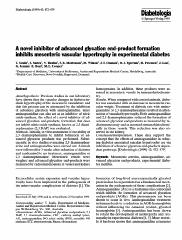Please use this identifier to cite or link to this item:
https://ahro.austin.org.au/austinjspui/handle/1/9152| Title: | A novel inhibitor of advanced glycation end-product formation inhibits mesenteric vascular hypertrophy in experimental diabetes. | Austin Authors: | Soulis, T;Sastra, S;Thallas, Vicki;Mortensen, S B;Wilken, M;Clausen, J T;Bjerrum, O J;Petersen, H;Lau, J;Jerums, George ;Boel, E;Cooper, Mark E | Affiliation: | Department of Medicine, University of Melbourne, Austin and Repatriation Medical Centre, Heidelberg, Victoria, Australia | Issue Date: | 1-Apr-1999 | Publication information: | Diabetologia; 42(4): 472-9 | Abstract: | Previous studies in our laboratory have shown that the vascular changes in diabetes include hypertrophy of the mesenteric vasculature and that this process can be attenuated by the inhibition of advanced glycation with aminoguanidine. Since aminoguanidine can also act as an inhibitor of nitric oxide synthase, the effect of a novel inhibitor of advanced glycation end-products, formation that does not inhibit nitric oxide synthase, known as 2,3 diaminophenazine (2,3 DAP) was evaluated.Initially, in vitro assessment of the ability of 2,3 diaminophenazine to inhibit formation of advanced glycation products was performed. Subsequently, in vivo studies evaluating 2,3 diaminophenazine and aminoguanidine were carried out. Animals were followed for 3 weeks after induction of diabetes and randomised to no treatment, aminoguanidine or 2,3 diaminophenazine. Mesenteric vessels were weighed and advanced glycation end-products were measured by radioimmunoassay in vessel and kidney homogenates. In addition, these products were assessed in mesenteric vessels by immunohistochemistry.When compared with control animals, diabetes was associated with an increase in mesenteric vascular weight. Treatment of diabetic rats with aminoguanidine or 2,3 diaminophenazine resulted in attenuation of vascular hypertrophy. Both aminoguanidine and 2,3 diaminophenazine reduced the formation of advanced glycation end-products as measured by radioimmunoassay and as assessed immunohistochemically in these vessels. This reduction was also observed in the kidney.These data support the concept that the effects of aminoguanidine in reducing diabetes associated vascular hypertrophy are via inhibition of advanced glycation end-products dependent pathways. | Gov't Doc #: | 10230652 | URI: | https://ahro.austin.org.au/austinjspui/handle/1/9152 | DOI: | 10.1007/s001250051181 | Journal: | Diabetologia | URL: | https://pubmed.ncbi.nlm.nih.gov/10230652 | Type: | Journal Article | Subjects: | Animals Diabetes Mellitus, Experimental.complications.metabolism Diabetic Angiopathies.metabolism Enzyme Induction Glycosylation End Products, Advanced.metabolism Hypertrophy.prevention & control Male Mesenteric Arteries.pathology Mesenteric Veins.pathology Mice Nitric Oxide Synthase.biosynthesis Nitric Oxide Synthase Type II Phenazines.pharmacology Rabbits Radioimmunoassay Rats Rats, Sprague-Dawley |
| Appears in Collections: | Journal articles |
Files in This Item:
| File | Description | Size | Format | |
|---|---|---|---|---|
| 10230652.pdf | 249.26 kB | Adobe PDF |  View/Open |
Page view(s)
26
checked on Nov 19, 2024
Download(s)
134
checked on Nov 19, 2024
Google ScholarTM
Check
Items in AHRO are protected by copyright, with all rights reserved, unless otherwise indicated.
